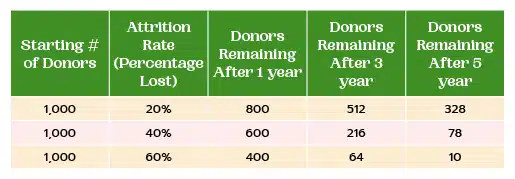A Guide to Donor Retention



If you’re a fundraiser or nonprofit development professional, you’ve likely heard the term “donor retention.” It’s one of the hottest topics of discussion in the nonprofit sector. But what exactly is donor retention? And why is it important?
Quite simply, donor retention is a measure of how many donors continue to donate to your organization. Nonprofits with a high donor retention rate have long-term supporters who come back year after year. Nonprofits with a low donor retention rate need to continually acquire new donors or larger gifts to keep up.
The Association of Fundraising Professionals (AFP) and the Center on Nonprofits and Philanthropy at the Urban Institute worked together to establish and maintain the Fundraising Effectiveness Project. The Fundraising Effectiveness Project provides a platform for these organizations to conduct research that helps nonprofits improve their fundraising results at a faster pace.
Each year, FEP releases the findings of its annual survey, including the average donor retention rates over the years. Bloomerang saw a consistent opportunity for nonprofits to improve their fundraising based on these average donor retention rates. As you can see below, the average donor retention rate for nonprofits stays right around 45%.
The FEP reports also explore donor frequency, specifically for new and repeat donors. New donor retention rates are even lower than the national average for all donors. However, if you can get a second donation (or golden donation), your retention rates increase dramatically because repeat donor retention is much higher.
Nonprofits that focus on receiving that golden donation naturally increase their average donor retention rate (about threefold!) because of this higher repeat retention rate.
“The donor retention landscape is actually lousy at the moment and is going of all accounts, from bad to worse. The latest round of AFP data that came out was made for very depressing reading. We’re continuing to lose donors at a pretty alarming rate.
Over 70% of people that we recruit into organizations never come back and make another gift, so we’re caught on this treadmill where we have to spend lots of money on acquisition which most nonprofits lose money on anyway, just to stand still.”
– Professor Adrian Sargeant,
Director of the Centre for Sustainable Philanthropy at Plymouth University
You can calculate your nonprofit’s donor retention rate by dividing the number of repeat donors this year by those that donated last year. For example, if you have 159 donors who gave again this year, but had 300 who gave last year, your donor retention rate would be 53%.
It can become tiresome to always calculate this equation by hand. We recommend investing in software that will help you automatically track your retention rate every year. This way, you’ll not only get today’s retention rate, but also an overview of how well your retention rate is improving over time.
You can also use our free donor retention calculator below to visualize how your donor retention rate can impact your fundraising revenue. Simply plug in some basic information about your fundraising efforts and current donor retention rate to see what an increase in donor retention can do for your fundraising campaigns.
Additional fundraising revenue
Additional years of giving from your existing group of donors
Maybe this is the first time you’ve ever thought about your donor retention rate, or maybe you’ve had a pretty good idea of what your rate is, but don’t think it’s anything to be worried about.
If you don’t worry about donor retention, you’ll risk a higher attrition rate (the rate at which donors are lost). This can make a huge impact on the number of donors in your donor database from year to year. Here’s what effect donor attrition can have on your donor database after five years:

You can see how quickly your pool of donors could evaporate. If you think those numbers are scary, wait until you see what that equates to in dollars and cents. Just a small change in your donor retention rate (for instance, 10%), can cost your organization thousands of dollars!
Maybe you’re thinking, “Okay, so what if donors don’t give in consecutive years? They might come back some day.”
Think again.
According to FEP, the recapture rate for lapsed donors is an astonishing 4% and has been on the decline for the last five years. If donors stop giving, there is a very small chance that they will ever give again.
This small recapture rate cannot be relied on to make up for low donor retention. If you have a 40% retention rate and a 60% attrition rate, you’ll only recapture about 4% of those donors that you lost. This is why it’s so important to retain donors from the beginning of their relationship with your organization.
If a new donor gives only once – as nearly 70% do – then you’re often left with a loss on your initial investment to gain that new donor. The true benefit of acquiring a donor can only come when that donor is retained over the long term.
While acquisition will always be important, nonprofits need to focus on ways to keep both new and existing donors coming back year after year.
Watch Bloomerang Co-Founder Jay Love discuss the donor retention issue with Amy Eisenstein, ACFRE in her video series for the Association of Fundraising Professionals.
Donor retention strategies are simple, but that’s not to say they’re easy. Oftentimes, it takes a large shift in the mindset of a nonprofit organization to begin focusing on retaining donors rather than just simply acquiring them.
As you consider the best donor retention strategies, think of the ways you can engage donors with the resources you already have, as well as with tools you’ll likely invest in. How can you easily offer additional ways to give or open up more engagement channels? For example, top donor engagement channels include recurring or monthly gifts to encourage long term engagements, peer-to-peer campaigns to turn donors into fundraisers, phone calls to first-time donors, and direct mail to break through the digital clutter and stand out to donors.
Besides leveraging your tools, remember that donors want to know the impact of their dollars. They want to know that your organization appreciates them and values their opinions. Make sure you not only thank your donors after they give but also when your campaign is over. That’s the perfect time to inform your supporters of the specific impacts this effort had on your mission. Overall, your donors are the real change agents for your mission and should be treated well with personalized communications, recognition, and gratitude.
Ensure your donor retention strategy includes the following components:
As your nonprofit focuses on improving its donor retention, it’s important that you have the best tools to track your donor retention rate and communications with supporters. What better place to do this than a donor database?
Bloomerang’s donor database is designed specifically with donor retention in mind. We don’t write a single line of code into our product without asking the question: will this help retain more donors?
We’re committed to helping nonprofits rise above the average retention rates in the sector, lower their fundraising costs, and raise the lifetime value of the donors in their community.
Read on to see exactly how Bloomerang can help you retain more donors.
What better way to keep donors at the center of your focus than by seeing your current retention rate, updated daily, right on your dashboard? With this feature, you can easily click through to see which donors have been retained and which need additional attention.
Bloomerang users can audit their written content (such as letters and emails) through a “You” test and a Reading Level test to help ensure that donor communications hit the mark every time.
There’s no need to scour data file after data file or cluttered lists for a constituent’s history with your organization. Bloomerang’s timeline visually represents all interactions, including giving and volunteerism, while highlighting significant trends.
Bloomerang users have the ability to automatically send email surveys to donors that measure satisfaction, commitment, intimacy, and trust in your organization — all without the need for additional software.
No matter how much a donor loves your mission and impact, they are not very likely to proactively inform you that they have a new address. Addresses are automatically updated in the Bloomerang database, and changes are displayed in the address note.
When a constituent donates for the first time, Bloomerang looks at a number of factors and automatically prioritizes the top five first-time donors you should call directly on the Bloomerang dashboard.
Looking for more donor retention tips? Check out these additional Bloomerang resources:
Comments